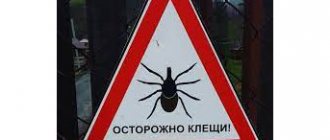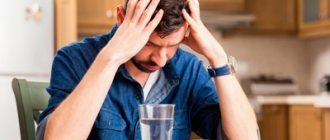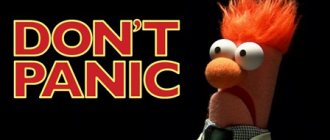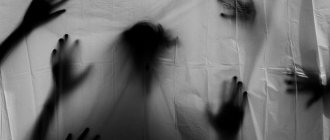general characteristics
Anxiety is expressed as a vague, vague fear of possible future events.
Often it occurs for no reason, that is, in situations where there is no real danger. A person anticipates trouble, but does not know how to avoid or overcome it. Internal tension is partially reduced by physical activity, so restless people cannot sit still, walk around the room, bite their nails, aimlessly turn on the mobile phone screen several times, and perform other seemingly meaningless actions. Anticipating trouble forces you to concentrate on finding ways to solve or avoid future problems. Absent-mindedness and some detachment from reality appear. Thinking becomes selective: a person pays attention to events related to the disturbing situation and ignores everything else. In this way he confirms that his experiences are justified. Sometimes the feeling of anxiety intensifies to a state of anxiety, and disturbances in the perception of time, space, people, and actions develop.
Subjectively, anxiety feels like anxiety - a combination of fear, sadness, shame, and guilt for no reason. During the most acute experiences, physiological changes begin to be realized: rapid heartbeat, increased sweating, nausea, dizziness, headaches. If there is no understanding of the connection between anxiety and physical ailment, a person looks for the cause of discomfort by turning to somatic doctors - therapists, neurologists, cardiologists.
The thinking of a restless person is directed from the past to the future - an unfavorable or dangerous event is extracted from memories, and then something similar is predicted. In this case, the previous experience can be old or just happened, personal or someone else’s. For example, after a boss reprimands, discomfort increases every time you come to the workplace, since there is a possibility of meeting the manager. Similarly, anxiety may develop before flying on an airplane if you have previously watched a movie about a plane crash.
Speaking about anxiety without a reason, it is worth noting that, as a rule, there is a reason, but it is not realized or is assessed by others as insignificant. The key function of anxiety is to encourage actions that increase the likelihood of a favorable outcome of events and prevent potentially dangerous behavior. The biological basis of this experience is the mobilization of psychophysiological processes to overcome a possible traumatic situation. The negative effect of anxiety is a feeling of fear that interferes with effective functioning.
What is anxiety?
Very often anxiety is confused with fear, but anxiety and fear are two different states, although they are inseparable from each other. Fear differs from anxiety in that there is always an object that causes this feeling, which can be met, seen, overcome.
With anxiety it's different. Often it exists on its own, without apparent reason. If anxious thoughts occur infrequently, and you can cope with them, then this is natural. However, if you don’t know how to get rid of the anxiety that constantly keeps you in suspense, you need the help of a specialist - there are signs of an incipient mental disorder.
Causes of anxiety
Depending on the cause of anxiety, there are three types of anxiety: adaptive, primary, secondary. In a situation of immediate danger, conflict or acute stress, anxiety develops as a reaction to mobilize the body: all systems are activated, preparing for fight or flight. Primary true anxiety, developing into anxiety, is observed with neuroses, secondary - with some somatic and mental illnesses, taking medications, narcotic drugs.
Adaptive response
In contrast to pathological anxiety for no reason, in the event of real danger, an adaptation reaction develops. It is manifested by the activation of physiological systems - increased breathing, increased heart rate, a rush of blood to the muscles, mental readiness to flee or fight. Stress factors, threats to life or health provoke feelings of anxiety, aggression, and anxiety. Such adaptation reactions are triggered in the following cases:
- Strict upbringing.
Within families where parents cultivate conscientiousness, integrity, and a sense of duty, the child does not have the freedom to express naturally existing fears and aggression. The suppression of these emotions leads to the consolidation of anxious and suspicious character traits, which are manifested by the fear of being open, obsessive fears, doubts, and uncertainty. A personality is formed with an increased level of anxiety and anxiety. - Unpredictability of behavior of others.
A state of constant adaptive readiness is necessary when interacting with unbalanced, emotionally unstable people and strangers. A feeling of anxiety is constantly present in children whose parents often change the rules of behavior (yesterday you couldn’t eat sweets, today you can). Other examples are speaking in front of an unfamiliar audience, talking with a hot-tempered boss. Stress prepares the psyche to quickly choose a reaction. - Danger situations.
When there is a real threat to well-being, concern arises for good reason. When the outcome of a situation is clearly dangerous (injury, serious illness, death), fear appears. If different outcomes are possible, a feeling of anxiety develops. Examples: waiting for the result of a medical examination in the presence of symptoms of illness, involuntary participation in hostilities, terrorist acts. - Conflict situations.
The clash of interests and different points of view is stressful. The psyche goes into a state of readiness for a quick reaction of defense, attack, or avoidance of conflict. Feeling anxious allows you to maintain a high level of tension. The more significant areas of life are affected in the confrontation, the more likely the development of a neurotic disorder with anxiety.
Primary concern
Persistent worry for no reason contributes to the appearance of anxiety - the dominant symptom of neurotic disorders. The development of neurosis occurs when situational anxiety manifests itself frequently, begins to spread to an increasingly wider range of events, and is felt almost constantly. Often a person understands that there is no reason for such experiences, but cannot change his condition. Feelings of anxiety are common in patients with the following neuroses:
- Generalized anxiety disorder.
In patients with this disease, feelings of anxiety and restless experiences are stable. Emotional stress has no connection with real events. Fears are general: fear of an accident, illness (in the absence of symptoms), sudden death. People report "a bad feeling," a constant expectation of bad news. Generalized anxiety is more common in women and is accompanied by autonomic disorders – trembling, dizziness, nausea. - Panic disorder.
Patients suffer from periodically recurring panic attacks - sudden fear, physical discomfort for no reason. Panic attacks last from 5 to 20 minutes and are accompanied by shortness of breath, rapid heartbeat, and chest pain. Anxiety is felt before an attack, when panic approaches. It is associated with the inability to control the attack and the fear of death. - Phobias.
Phobic disorders are characterized by a persistent, intense fear of specific objects or situations. The experiences are intense, often occur in the absence of a real threat, and cannot be controlled. They are caused by the potential possibility of developing a frightening situation or meeting an object of fear. Common options are claustrophobia, a feeling of intense fear from thoughts of meeting a dog, climbing to heights, or using a public toilet. - PTSD.
Post-traumatic stress is the consequences of a traumatic event (war, violence) with re-experiencing what happened in dreams and thoughts, mental numbness, and increased excitability. Anxiety often develops in the first stage, when a high focus on the trauma is maintained. Patients mentally return to the past and do not adapt well to real life. - Psychosomatic disorders.
In somatoform disorders, health concerns dominate - patients complain of somatic ailments, but medical examinations do not confirm the presence of the disease. A complex of experiences is formed due to increased attentiveness to body signals and lack of diagnosis. - Obsessive-compulsive neurosis.
Obsessive-compulsive neurosis is represented by obsessive thoughts and repetitive actions that relieve mental discomfort. The person is concerned about the presence of anxious thoughts and the inability to control them. The most common variant of obsessional neurosis is the idea that surrounding objects are contagious and frequent hand washing.
Secondary concern
Experiencing anxiety for no reason can be a symptom of mental disorders or somatic diseases, a side effect of medications, or the result of taking psychoactive substances. In all these cases, the feeling of anxiety arises secondary, not because of external events and their assessment, but as a result of physiological changes. Restless states develop when certain areas of the brain are damaged, with biochemical changes with increased production of neurotransmitters and hormones. The symptom is characteristic of a number of diseases, such as:
- Depression.
The physiological basis of anxiety and depressive disorders is a disturbance in the metabolism of serotonin and dopamine. A deficiency of these compounds in the areas of the brain responsible for emotional reactions is manifested by a state of depression, causeless anxiety, and restlessness. The trigger for depression can be an external negative event or direct biochemical changes (hereditary, provoked by diseases). - Schizophrenia.
Restless thoughts are typical of the paranoid form of schizophrenia. They are caused by delusions and hallucinations: ideas of persecution, suggestions by voices of various violent actions. In addition, concern about one’s own condition is observed in patients in the initial stages of schizophrenia, when for no reason there is a feeling of disorientation in one’s own personality and environment. - Organic brain lesions.
Symptoms of anxiety are found in diseases affecting the functioning of the reticular formation, namely the activity of the locus coeruleus. Axons from this nucleus ascend to the upper layers of the cerebral cortex, the cerebellar cortex, the hippocampus and other structures involved in the formation of emotions. Damages to these parts of the brain are represented by vascular, traumatic, tumor, and neurodegenerative pathologies. - Endocrine diseases.
Hormonal changes are often accompanied by the development of psycho-emotional disorders. Mood disorders are varied and appear without cause. The most common depressive states are anxiety, worry, and fear. They are provoked by an increase in thyroid hormones and adrenal cortex. Observed in thyrotoxicosis, hypercortisolism syndrome, Itsenko-Cushing's disease. - Taking psychostimulants.
Psychostimulants, including narcotic drugs, have a stimulating effect on the nervous system. They enhance the transmission of neurosignals in various parts of the brain, causing restless thoughts, panic, and sometimes hallucinations, illusions, and psychosis. The most pronounced persistent symptoms of psychoemotional disorder are a consequence of long-term drug use.
Signs of the syndrome
A panic attack usually develops suddenly. And he can find the patient anywhere, at any time of the day. Its manifestations vary: from an uncontrollable, painful feeling of fear and anxiety to internal discomfort. A panic attack with mild symptoms is called “panic without panic.” In this case, physiological symptoms dominate.
The duration of the attack may be only a few minutes, in other cases it lasts several hours. But on average its duration is 20–30 minutes. PAs are repeated in one situation 1–2 times a day, in others – several times a month. Having experienced such sensations for the first time, a person retains the memory of them for the rest of his life.
There is an incredible accident when a patient experiences attacks only a couple of times in his entire life. They disappear without a trace, presumably after the stress factor ends.
A panic attack is accompanied by the following symptoms:
| Psychological | Physiological (vegetative) |
|
|
The first case of a panic attack is expressed by an extremely strong fear of dying. Its power is so powerful that it can drive the patient into a state of passion. In subsequent cases, the feeling of imminent death is transformed into a specific phobia. This could be a fear of going crazy, suffocating, etc.
There are situations when the condition is not accompanied by an anxiety-phobic complex. Emotional symptoms come to the fore: apathy, a feeling of uselessness, aggression, nervousness.
After a paroxysm, patients feel exhausted and overwhelmed.
Panic attacks most often occur between the ages of 25 and 50. Approximately 5% of humanity suffers from the pathology. And what’s interesting is that they are mostly residents of large cities. In old age, such paroxysms occur rarely, have an erased character and become remnants of attacks that occurred in youth.
Those who have experienced a similar condition at least once in their lives describe it with horror and excitement.
For example, a girl had an attack while she was driving in a car with her husband and child. There was a feeling of lack of air, an unreal horror ran through from head to toe. In an instant there was a desire to open the door and jump out of the salon. The busy highway held me back.
Another patient was seized with fear when certain sounds appeared. I felt a nasty tingling sensation in my palms. Excitement sets in, causing your thoughts to become confused and your tongue to be taken away.
A woman described her husband experiencing a panic attack while they were walking in the park and talking about a relative who had recently had a heart attack. She noticed that her husband's arms and shoulders suddenly began to shake. He was covered in sweat, it was even dripping. His face turned pale, he practically stopped breathing (he couldn’t take a breath), his gaze was wandering and unconscious. The man was sure he was dying. It took almost 2 hours to get home, whereas it usually took 20 minutes. He constantly stopped, sat down on the ground, and the attack repeated.
Survey
A persistent feeling of anxiety may be a symptom of physical or mental illness. Diagnosis of this condition is carried out by psychiatrists, psychotherapists, and psychologists. When a patient contacts specialists, a clinical interview is initially carried out, during which the duration of the emotional disorder, the frequency and severity of anxiety states, and possible causes are clarified. In addition to the conversation, the following diagnostic methods are informative:
- Observation.
Patients are characterized by restlessness, emotional instability, and absent-mindedness. It can be difficult for them to distract themselves from their own experiences and concentrate on the doctor’s words. During the consultation, they often change their body position for no reason and move their hands through objects (clothing fasteners, telephone, bag). Obsessive actions designed to reduce tension are possible. - Psychodiagnostic questionnaires.
To determine the level of anxiety, special psychological tests are used: Taylor's Explicit Anxiety Scale, Spielberger's Anxiety Scale, Kondash's Social-Situational Fear Scale. The results make it possible to quantify how severe the feeling of anxiety, worry, and fear is. - Projective tests
. To identify a hidden or denied emotional state by the patient, projective research methods are used: drawing tests, tests of interpretation of unstructured drawing material. Examples of such techniques are drawing of a person, Rorschach test, TAT. Based on the results, it is possible to determine the presence of anxiety and suggest its origin.
If restless thoughts and experiences exist without a reason, the patient is referred for consultation to a neurologist or endocrinologist. Subspecialists determine the presence or absence of endocrine and neurological diseases as a factor in the development of emotional disorders. A survey is carried out to clarify somatic complaints (pain, malaise), examination, laboratory blood tests for hormone levels, instrumental studies of the brain and the vessels that feed it.
help yourself
At the moment when you are overtaken by an attack, it is very difficult to control yourself. But you can try to pull yourself together and help yourself get rid of it quickly:
- Go out into the fresh air or open the windows, unbutton tight clothes. Pour cool water over your face.
- It is important to switch to breathing. Try to breathe deeply, slowly and fully. To increase the level of carbon dioxide in the blood, breathe into a bag or cupped palms (imitate the position of breathing into them, trying to warm them up).
- Try to think about something positive or talk to someone. Try counting to 100 or count passing cars or trees if fear catches you in transport or on the street. All this helps to shift attention away from anxious feelings. If the cause of alarm is a certain place, hurry to leave it.
- To stabilize your body, place your hands on a stable surface or press your feet into the floor. This position will give you a feeling of confidence and control.
- Keep telling yourself that this will all end now. The anxiety that arises will not harm you, it is simply a figment of your imagination.
If you witness an attack on someone, you can help the person cope with the problem. The main thing: do not panic yourself! You must be calm. And with your calmness set an example for him.
Talk to him, hug him on the shoulder or squeeze his hand. Show me how to breathe correctly. If conditions permit, give the person water or warm tea.
The main thing is not to get confused in this situation. Remember, your behavior can significantly alleviate the panicker’s condition.
Treatment
The therapeutic process begins with a conversation with a doctor, during which the specialist talks about methods of treating the underlying disease and eliminating anxiety. Methods of symptomatic treatment are selected individually, taking into account the cause and severity of the emotional disturbance and the patient’s attitude towards it. For neurotic disorders, psychotherapy sessions are more appropriate; for secondary anxiety caused by a somatic illness, pharmacotherapy is more appropriate.
Relaxation techniques are effective in relieving anxiety
Psychotherapy
Feelings of anxiety can be effectively corrected using a combination of cognitive behavioral therapy techniques. At the first stage - the stage of mental elaboration - the psychotherapist discusses with the patient the causes of anxiety and situations that provoke emotional tension. He teaches how to identify physical discomfort and changes in thoughts when experiencing anxiety. At the stage of behavioral correction, the exposure method can be used, when the patient creates a vivid mental image of a dangerous situation, while simultaneously using relaxation and deep breathing techniques, visualizing a successful outcome of the event.
Severe forms of anxiety disorders, accompanied by pronounced autonomic reactions and feelings of fear, require a slightly different sequence of psychotherapy. First, the patient is taught self-control: restoring normal breathing, distraction and switching attention. When a person becomes able to independently avoid attacks of fear and panic, they move on to the stage of behavioral therapy.
Drug therapy
Medicines are prescribed for severe anxiety due to a mental disorder, neurological or endocrine disease. Drug correction allows you to control the symptom, even if it occurs without an obvious cause. Its advantage is its rapid action - improvement appears before the patient feels the positive effects of psychotherapy or other primary treatment. The use of tranquilizers – anti-anxiety drugs – is widespread. Additionally, antidepressants and herbal remedies with a calming and sedative effect are prescribed.
Relaxation techniques
Mild forms of anxiety can be eliminated through regular practice of physical and mental relaxation. Training in relaxation techniques is more successful in group classes that combine breathing exercises and auto-training. Patients develop muscle sense, master progressive relaxation, abdominal breathing, and applied relaxation. By controlling muscle tension and the breathing cycle, emotions and thoughts are corrected. Breathing yoga can be considered as an alternative to psychotherapeutic group techniques.
Night PA
A panic attack can strike a person at any moment, even at night. At night, in silence and in the dark, when the patient has nothing to distract himself with, he concentrates on his thoughts of a varied nature, including negative ones.
Another reason is nightmares. But do not confuse the attack itself with a terrifying dream. Paroxysm develops after a nightmare has been seen. And it cannot be forgotten, unlike a dream.
If we are talking about panic attacks of falling asleep, then they most often occur between 00.00–4.00 in the morning. The attack can also awaken its victim in the middle of sleep.
Nighttime PA significantly undermines human health. He suffers from sleep disorders, usually insomnia or problems falling asleep.
Insufficient rest at night provokes headaches and chronic fatigue during the day. The patient's productive activity decreases. He becomes nervous and irritable. The mood becomes depressive.
The symptoms of night attacks repeat the typical manifestations of the condition and also contribute to the development of phobias. So, after the death of her father, the girl began to have panic attacks. She noted that she experienced respiratory spasms at night. Often the thought appeared that he might not wake up. She even asked her friends to call in the morning to check if she was alive.
If a person, during a paroxysm at night, feels disconnected from reality and does not understand what is happening to him, then this feeling persists during the day. An exhausted nervous system that did not have time to recover overnight does not perceive objective reality. The patient does not understand who he is and what is happening to him.
A panic attack of awakening occurs early in the morning. The patient wakes up from a sudden and overwhelming feeling of anxiety. Gradually, other symptoms join in. Naturally, a person can no longer fall asleep, and he feels exhausted and unrested.
Symptoms of panic attacks after sleep
Often, the main signs of morning anxiety overlap with the symptoms of obsessive-compulsive disorder, among which it is worth noting:
- surprise of manifestation;
- duration from 10 minutes to half an hour;
- time sign
: earlier in the morning or the first minutes after waking up; - physiological signs
: weakness and rapid heartbeat, tremors, chills, sweating, changes in body temperature, chest pain, similar to signs of a heart attack; - obsessive scary thoughts.
Some patients experience a panic attack once every six months, while others may experience it every day, but in any case, this is a reason to consult a specialist.
How to get rid of anxiety if it is caused by a mental disorder
In this case, breathing deeply is, unfortunately, almost useless. If your anxiety has reached the level of mental illness, you will need help.
Talk to your doctor
To start, you can visit a therapist, tell him about your symptoms and ask for recommendations.
The sooner you seek help, the easier it will be to regain your cheerfulness and positive attitude towards the world.
Another option is to immediately contact a psychotherapist. A specialist will be able to determine exactly what is happening to you and what kind of disorder is interfering with your life.
Change your lifestyle
Most likely, first of all, the doctor will advise Anxiety disorders to reconsider your habits.
- Avoid alcohol, coffee, high-sugar drinks and energy drinks. They excite the nervous system and can increase anxiety.
- Exercise regularly. Exercise increases levels of endorphins, hormones associated with a good mood.
- Eat well. This will increase your body's reserves and reduce the negative effects of the fight or flight response.
- Sleep at least 8 hours.
- Try relaxation techniques. This could be regular meditation or yoga classes.
Get psychotherapy
This is the most effective way to cope with anxiety and other disorders. There are different types of psychotherapy, but the most popular Therapy for Anxiety Disorders are cognitive-behavioral and exposure.
Cognitive behavioral therapy
Her idea is that how you feel depends not on the stressful situation, but on how you feel about it. Therefore, the therapist will teach you
- Identify negative thoughts—what exactly are you thinking about when you start to worry. Example: “They will laugh at me.”
- Evaluate and challenge negativity. This means asking questions: “Is the bad thing that scares me really going to happen? And if so, will it really have catastrophic consequences? Maybe it’s not so scary?”
- Replace negative thoughts with realistic ones.
Diagnosis of anxiety disorders
Diagnostic criteria:
To assess whether a particular patient suffers from anxiety, it is advisable to rule out the presence of a systemic disorder. To do this, the doctor must take into account the following aspects:
- Physical symptoms.
- Previous medical and psychological history of the patient and his family.
- The possibility of suffering from an illness that causes an anxiety disorder.
- The influence of toxins such as caffeine, cannabis or cocaine.
Interview:
The clinical interview is the primary tool for making a diagnosis of anxiety disorders and gaining a general understanding of the patient. It must collect the necessary information and usually consists of four stages:
- Preliminary stage: The goal is to find out the reason for the consultation.
- Exploratory phase: Symptoms, location, intensity, chronology and evolution.
- The presence of organic pathologies.
- Direct triggers such as life changes, traumatic events and so on.
- Personal history: manic episodes, previous depression, etc.
- Study of the psychosocial sphere: beliefs and expectations, thoughts, affect and social and family environment, personality.
The risk of misdiagnosis has led to a large number of structured scales to identify the disorder. These scales by themselves are not sufficient to establish a diagnosis, but they help identify people susceptible to mental pathology who need to be subjected to more in-depth study. Some of the most commonly used scales are the Goldberg Anxiety and Depression Scale and the Hamilton Anxiety Scale.
Tips to help you cope with a morning panic attack
It is logical to assume that most often an attack occurs to the patient at the most inopportune time, precisely when he is alone. What can you do to help yourself calm down quickly and return to normal daily activities?
- The first thing a patient should recite
to himself as a mantra? "I'm not in any danger." As we know, a panic attack is extremely rarely associated with a real threat. What can threaten a person in his own home in his own bed? However, in the state of an attack it is quite difficult to reach such awareness. That is why psychotherapists recommend simply trying to distract yourself: counting the objects around you, saying a nursery rhyme, etc., shifting the focus of attention to external mechanical actions. - Breathing practices
. The main therapeutic method for all anxiety disorders. The first disorder that the patient encounters on a physical level is breathing problems, difficulty in inhaling, a feeling of lack of oxygen, etc. In this case, it is very important to exhale as deeply as possible with a medium inhalation; the exhalation can also be voiced. Another exercise involves inhaling slowly for 4 counts, holding your breath for 2 counts and exhaling slowly for 4 counts, followed again by a two-second pause. - Game of emotions
. The patient is asked to act out various emotions on his face: joy, anger, surprise, boredom. Muscle activity on the face very often helps to calm down and relieve an attack-like state.
How to get rid of anxiety if it is not associated with a mental disorder
In this case, the usual methods to control stress will help. There are dozens of them. Here are the most popular and effective.
Take a few deep breaths and long exhalations
Scientists at Stanford University discovered Study shows how slow breathing induces tranquility in an area in the brain that links the frequency and depth of breathing and emotional state. As it turns out, the more active and shallow we breathe, the more nervousness and excitement we experience.
Play soothing music or listen to the sounds of nature
In 2022, researchers proved IT'S TRUE – THE SOUND OF NATURE HELPS US RELA: when people listen to the sounds of nature, their stress levels noticeably decrease. The same goes for calm, muted music.
By the way, here is the most soothing track recorded by scientists from the British Academy of Sound Therapy:
Switch away from the topic that's causing you anxiety.
For example, if you are nervous about the news, turn off the TV and log off from social media. Instead, watch a comedy or melodrama, read a book, play with your cat, call a friend. Your task is to occupy your head with something else, to take your mind off the stressful situation.
Keep your hands busy
There are many options. Start knitting. Plant flowers under the windows. Read a book to your child or do a couple of physical experiments with him. Wash the dishes or clean the apartment. These classes will help you switch.
Learn to tell yourself “stop”
Watch your thoughts and stop in time. If you find yourself thinking about something disturbing, become aware of this fact. Imagine taking the worrying thought into your fist and putting it aside. And then consciously start thinking about something else - about the situation that you can control.
Try also











